Climate Trends and Extremes in the Indus River Basin, Pakistan: Implications for Agricultural Production
Abstract
:1. Introduction
2. Materials and Methods
2.1. Area of Study
2.2. Observational Data
2.3. Extreme Climate and Crop-Specific Indicators
2.4. Trend Analysis
2.5. Statistical Downscaling
3. Results and Discussion
3.1. Observed Historical Climate
3.1.1. Trends in Precipitation and Temperatures
3.1.2. Trends in Extreme Climate Indicators
3.2. Projected Future Climate
3.2.1. Changes in Precipitation and Temperatures
3.2.2. Change in Crop-Specific Temperature-Based Indicators
4. Conclusions
Author Contributions
Funding
Institutional Review Board Statement
Informed Consent Statement
Data Availability Statement
Acknowledgments
Conflicts of Interest
References
- Pakistan Ministry of Finance: Pakistan Economic Survey 2016–2017. 2017. Available online: https://www.finance.gov.pk/survey/chapters_17/Pakistan_ES_2016_17_pdf.pdf (accessed on 17 May 2021).
- Eckstein, D.; Künzel, V.; Schäfer, L.; Winges, M. Global Climate Risk Index 2020. Germanwatch 2019. Available online: https://germanwatch.org/sites/default/files/20-2-01e%20Global%20Climate%20Risk%20Index%202020_15.pdf (accessed on 17 May 2021).
- Ministry of Climate Change (Government of Pakistan). Pakistan’s Second National Communication on Climate Change; Technical Report; Ministry of Climate Change: Islamabad, Pakistan, 2019.
- Hanif, U.; Syed, S.H.; Ahmad, R.; Malik, K.A.; Nasir, M. Economic Impact of Climate Change on the Agricultural Sector of Punjab. 2010. Available online: http://www.jstor.org/stable/41428690 (accessed on 17 May 2021).
- Nomman, A.; Schmitz, M. Economic assessment of the impact of climate change on the agriculture of Pakistan. Bus. Econ. Horiz. (BEH) 2011, 4, 1–12. [Google Scholar] [CrossRef]
- Abid, M.; Schilling, J.; Scheffran, J.; Zulfiqar, F. Climate change vulnerability, adaptation and risk perceptions at farm level in Punjab, Pakistan. Sci. Total Environ. 2016, 547, 447–460. [Google Scholar] [CrossRef]
- Chaudhry, Q.U.Z.; Mahmood, A.; Rasul, G.; Afzaal, M. Climate change indicators of Pakistan. Pak. Meterol. Dep. 2009, PMD-22/2009, 1–43. [Google Scholar]
- Rasul, G.; Mahmood, A.; Sadiq, A.; Khan, S. Vulnerability of the Indus delta to climate change in Pakistan. Pak. J. Meteorol. 2012, 8, 89–107. [Google Scholar]
- Aryal, J.P.; Sapkota, T.B.; Khurana, R.; Khatri-Chhetri, A.; Rahut, D.B.; Jat, M.L. Climate change and agriculture in South Asia: Adaptation options in smallholder production systems. Environ. Dev. Sustain. 2020, 22, 5045–5075. [Google Scholar] [CrossRef] [Green Version]
- FAO. AQUASTAT Main Database, Food and Agriculture Organization of the United Nations (FAO). 2016. Available online: http://www.fao.org/aquastat/en/databases/maindatabase (accessed on 18 January 2022).
- Chaudhry, Q.U.Z. Climate Change Profile of Pakistan; Asian Development Bank: Mandaluyong City, Philippines, 2017. [Google Scholar]
- Ahmad, B.; Rana, A.; Abuzar, K.; Kiran, R.; Mansoor, R.; Kubra, S. Diagnostic study of heavy downpour in 2015 flash floods over Chitral Area, Northern Pakistan. Pak. J. Meteorol. 2016, 12, 79–93. [Google Scholar]
- Lutz, A.F.; Immerzeel, W.W.; Kraaijenbrink, P.D.A.; Shrestha, A.B.; Bierkens, M.F.P. Climate Change Impacts on the Upper Indus Hydrology: Sources, Shifts and Extremes. PLoS ONE 2016, 11, e0165630. [Google Scholar] [CrossRef] [Green Version]
- Ali, S.; Li, D.; Congbin, F.; Khan, F. Twenty first century climatic and hydrological changes over Upper Indus Basin of Himalayan region of Pakistan. Environ. Res. Lett. 2015, 10, 014007. [Google Scholar] [CrossRef]
- Zahid, M.; Rasul, G. Frequency of extreme temperature and precipitation events in Pakistan 1965–2009. Sci. Int. 2011, 23, 313–319. [Google Scholar]
- Pakistan Ministry of Finance: Pakistan Economic Survey 2010–2011. 2011. Available online: http://www.finance.gov.pk/survey/chapter_11/Highlights.pdf (accessed on 17 May 2021).
- World Meteorological Organization (WMO). State of the Global Climate 2020, Technical Report. 2021. Available online: https://library.wmo.int/doc_num.php?explnum_id=10618 (accessed on 17 May 2021).
- Sheikh, M.M.; Manzoor, N.; Adnan, M.; Ashraf, J.; Khan, A.M. Climate Profile and Past Climate Changes in Pakistan; Technical report; Global Change Impact Studies Centre: Islabamad, Pakistan, 2009.
- Ahmad, B.; Mahmood, S. Observed, Simulated and Projected Extreme Climate Indices over Pakistan; Anchor Academic Publishing: Hamburg, Germany, 2017. [Google Scholar]
- Ikram, F.; Afzaal, M.; Bukhari, S.; Ahmed, B. Past and future trends in frequency of heavy rainfall events over Pakistan. Pak. J. Meteorol. Vol. 2016, 12, 57–78. [Google Scholar]
- Rajbhandari, R.; Shrestha, A.B.; Kulkarni, A.; Patwardhan, S.K.; Bajracharya, S.R. Projected changes in climate over the Indus river basin using a high resolution regional climate model (PRECIS). Clim. Dyn. 2015, 44, 339–357. [Google Scholar] [CrossRef] [Green Version]
- Ullah, A.; Salehnia, N.; Kolsoumi, S.; Ahmad, A.; Khaliq, T. Prediction of effective climate change indicators using statistical downscaling approach and impact assessment on pearl millet (Pennisetum glaucum L.) yield through Genetic Algorithm in Punjab, Pakistan. Ecol. Indic. 2018, 90, 569–576. [Google Scholar] [CrossRef]
- Ali, M.A.; Hassan, M.; Mehmood, M.; Kazmi, D.H.; Chishtie, F.A.; Shahid, I. The Potential Impact of Climate Extremes on Cotton and Wheat Crops in Southern Punjab, Pakistan. Sustainability 2022, 14, 1609. [Google Scholar] [CrossRef]
- Pakistan Bureau of Statistics: Agricultural Statistics of Pakistan 2010–2011. 2011. Available online: https://www.pbs.gov.pk/content/agriculture-statistics-pakistan-2010-11 (accessed on 17 May 2021).
- Satake, T.; Yoshida, S. High Temperature-Induced Sterility in Indica Rices at Flowering. Jpn. J. Crop Sci. 1978, 47, 6–17. [Google Scholar] [CrossRef] [Green Version]
- Gawith, J.R.P.M. Temperatures and the growth and development of wheat: A review. Eur. J. Agron. 1999, 10, 23–36. [Google Scholar] [CrossRef]
- Wahid, A.; Close, T. Expression of dehydrins under heat stress and their relationship with water relations of sugarcane leaves. Biol. Plant. 2007, 51, 104–109. [Google Scholar] [CrossRef]
- Carmo-Silva, A.E.; Gore, M.A.; Andrade-Sanchez, P.; French, A.N.; Hunsaker, D.J.; Salvucci, M.E. Decreased CO2 availability and inactivation of Rubisco limit photosynthesis in cotton plants under heat and drought stress in the field. Environ. Exp. Bot. 2012, 83, 1–11. [Google Scholar] [CrossRef]
- Baker, J.T.; Boote, K.J.; Allen, L.H., Jr. Potential Climate Change Effects on Rice: Carbon Dioxide and Temperature. In Climate Change and Agriculture: Analysis of Potential International Impacts; John Wiley & Sons, Ltd.: Hoboken, NJ, USA, 2015; Chapter 2; pp. 31–47. [Google Scholar] [CrossRef]
- Mann, H.B. Nonparametric tests against trend. Econom. J. Econom. Soc. 1945, 13, 245–259. [Google Scholar] [CrossRef]
- Kendall, M. Rank Correlation Methods, 4th ed.; Charles Griffin: San Francisco, CA, USA, 1975. [Google Scholar]
- Gilbert, R.O. Statistical Methods for Environmental Pollution Monitoring; Wiley: New York, NY, USA, 1987. [Google Scholar]
- van Belle, G.; Hughes, J.P. Nonparametric Tests for Trend in Water Quality. Water Resour. Res. 1984, 20, 127–136. [Google Scholar] [CrossRef]
- Zhang, X.; Harvey, K.D.; Hogg, W.D.; Yuzyk, T.R. Trends in Canadian streamflow. Water Resour. Res. 2001, 37, 987–998. [Google Scholar] [CrossRef]
- Elnur, D.H.B.M.A.H. Detection of hydrologic trends and variability. J. Hydrol. 2002, 255, 107–122. [Google Scholar] [CrossRef]
- Partal, T.; Kahya, E. Trend analysis in Turkish precipitation data. Hydrol. Process. 2006, 20, 2011–2026. [Google Scholar] [CrossRef]
- Obot, N.; Chendo, M.; Udo, S.; Ewona, I. Evaluation of rainfall trends in Nigeria for 30 years (1978–2007). Int. J. Phys. Sci. 2010, 5, 2217–2222. [Google Scholar]
- Manzanas, R.; Amekudzi, L.K.; Preko, K.; Herrera, S.; Gutiérrez, J.M. Precipitation variability and trends in Ghana: An intercomparison of observational and reanalysis products. Clim. Chang. 2014, 124, 805–819. [Google Scholar] [CrossRef] [Green Version]
- Alvar-Beltrán, J.; Heureux, A.; Soldan, R.; Manzanas, R.; Khan, B.; Dalla Marta, A. Assessing the impact of climate change on wheat and sugarcane with the AquaCrop model along the Indus River Basin, Pakistan. Agric. Water Manag. 2021, 253, 106909. [Google Scholar] [CrossRef]
- Thomson, A.M.; Calvin, K.V.; Smith, S.J.; Kyle, G.P.; Volke, A.; Patel, P.; Delgado-Arias, S.; Bond-Lamberty, B.; Wise, M.A.; Clarke, L.E.; et al. RCP4.5: A pathway for stabilization of radiative forcing by 2100. Clim. Chang. 2011, 109, 77–94. [Google Scholar] [CrossRef] [Green Version]
- Riahi, K.; Rao, S.; Krey, V.; Cho, C.; Chirkov, V.; Fischer, G.; Kindermann, G.; Nakicenovic, N.; Rafaj, P. RCP8.5—A scenario of comparatively high greenhouse gas emissions. Clim. Chang. 2011, 109, 33. [Google Scholar] [CrossRef] [Green Version]
- Chylek, P.; Li, J.; Dubey, M.K.; Wang, M.; Lesins, G. Observed and model simulated 20th century Arctic temperature variability: Canadian Earth System Model CanESM2. Atmos. Chem. Phys. Discuss. 2011, 11, 22893–22907. [Google Scholar] [CrossRef]
- Voldoire, A.; Sánchez-Gómez, E.; Salas y Mélia, D.; Decharme, B.; Cassou, C.; Sénési, S.; Valcke, S.; Beau, I.; Alias, A.; Chevallier, M.; et al. The CNRM-CM5.1 global climate model: Description and basic evaluation. Clim. Dyn. 2013, 40, 2091–2121. [Google Scholar] [CrossRef] [Green Version]
- Giorgetta, M.A.; Jungclaus, J.; Reick, C.H.; Legutke, S.; Bader, J.; Böttinger, M.; Brovkin, V.; Crueger, T.; Esch, M.; Fieg, K.; et al. Climate and carbon cycle changes from 1850 to 2100 in MPI-ESM simulations for the Coupled Model Intercomparison Project phase 5. J. Adv. Model. Earth Syst. 2013, 5, 572–597. [Google Scholar] [CrossRef]
- Bentsen, M.; Bethke, I.; Debernard, J.B.; Iversen, T.; Kirkevåg, A.; Seland, Ø.; Drange, H.; Roelandt, C.; Seierstad, I.A.; Hoose, C.; et al. The Norwegian Earth System Model, NorESM1-M – Part 1: Description and basic evaluation of the physical climate. Geosci. Model Dev. 2013, 6, 687–720. [Google Scholar] [CrossRef] [Green Version]
- Akter, N.; Rafiqul Islam, M. Heat stress effects and management in wheat. A review. Agron. Sustain. Dev. 2017, 37, 37. [Google Scholar] [CrossRef]
- Kakani, V.; Reddy, K.; Koti, S.; Wallace, T.; Prasad, P.; Reddy, V.; Zhao, D. Differences in in vitro pollen germination and pollen tube growth of cotton cultivars in response to high temperature. Ann. Bot. 2005, 96, 59–67. [Google Scholar] [CrossRef] [PubMed] [Green Version]
- Jagadish, S.; Murty, M.; Quick, W. Rice responses to rising temperatures: Challenges, perspectives and future directions. Plant Cell Environ. 2015, 38, 1686–1698. [Google Scholar] [CrossRef]
- Tai, P.; Lentini, R. Freeze Damage of Florida Sugarcane. In Sugarcane Handbook, 1st ed.; Anderson, D.L., Ed.; University of Florida Cooperative Extension Service, Institute of Food and Agricultural Sciences: Gainesville, FL, USA, 1998; pp. 1–3. [Google Scholar]
- Sanghera, G.S.; Malhotra, P.K.; Singh, H.; Bhatt, R. Climate change impact in sugarcane agriculture and mitigation strategies. Harnessing Plant Biotechnol. Physiol. Stimul. Agric. Growth 2019, 99–115. [Google Scholar]
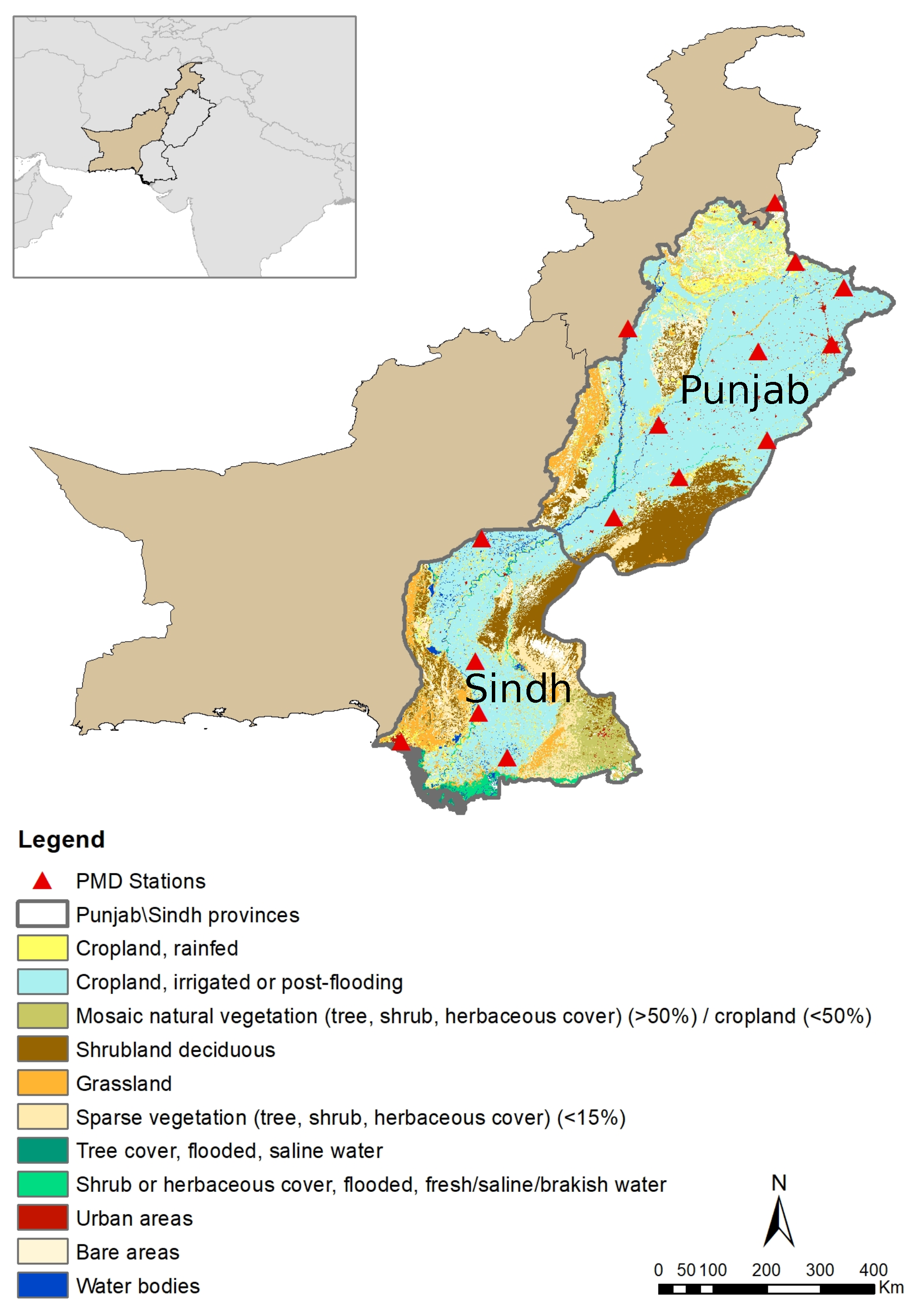

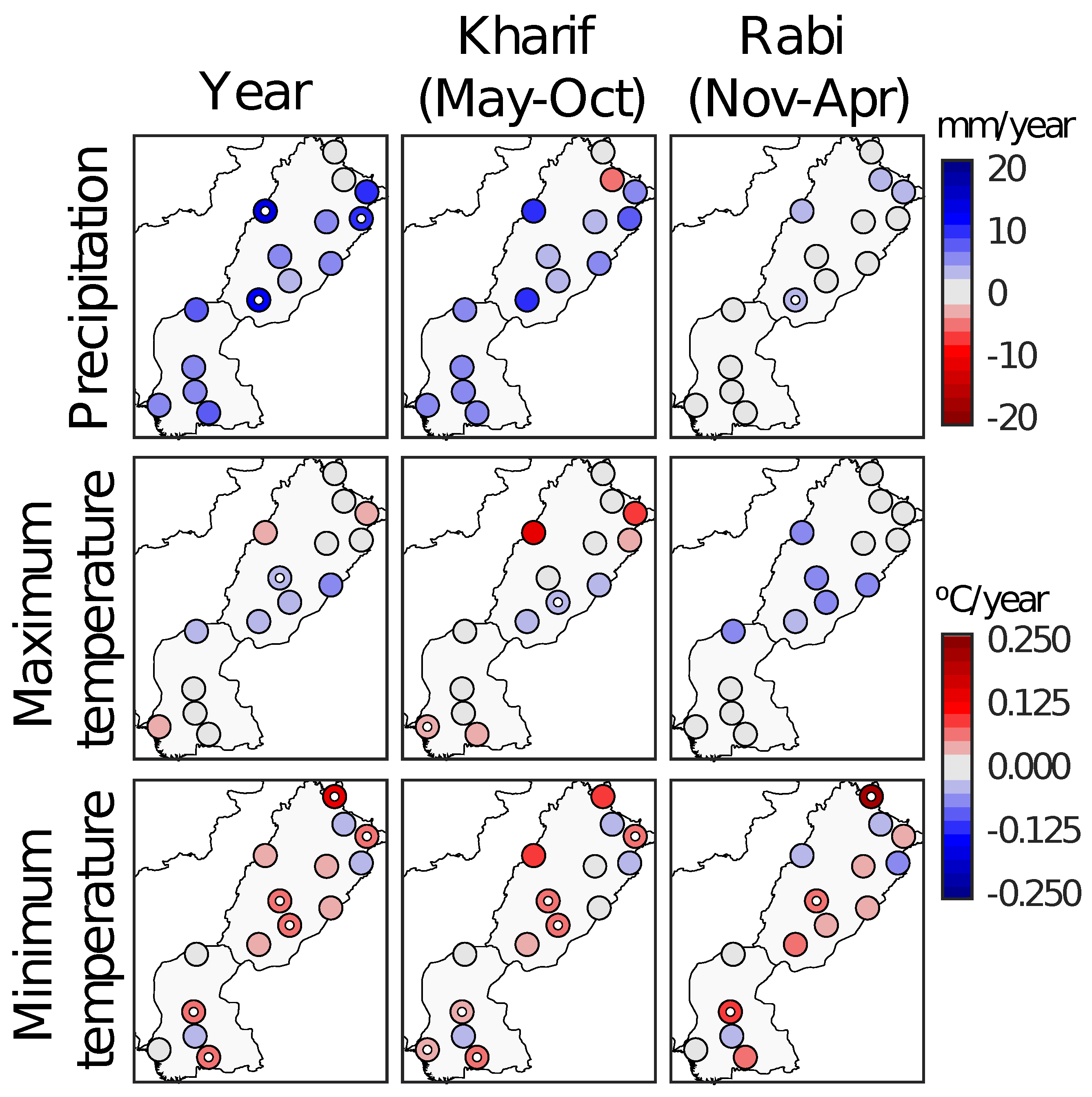
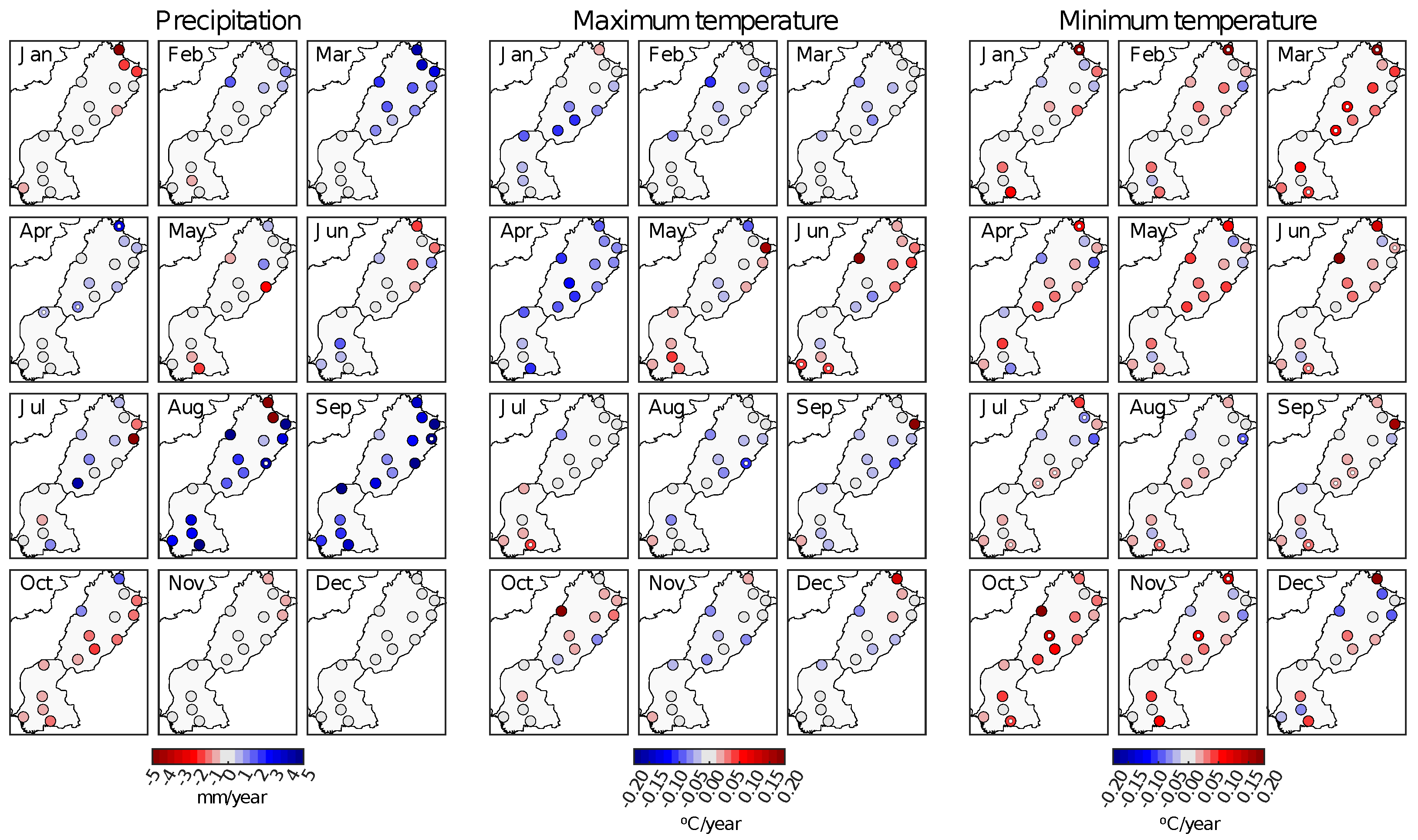

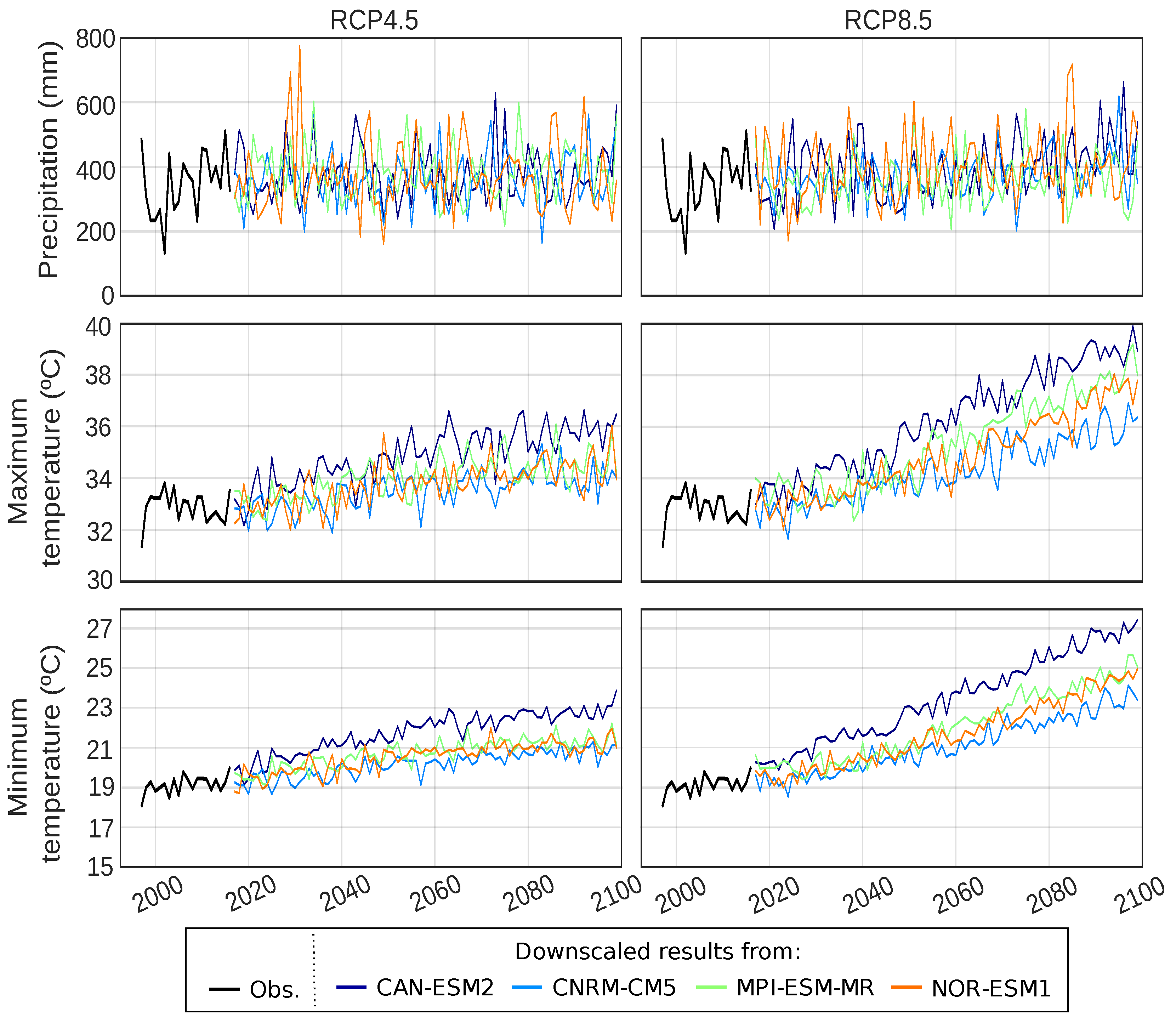
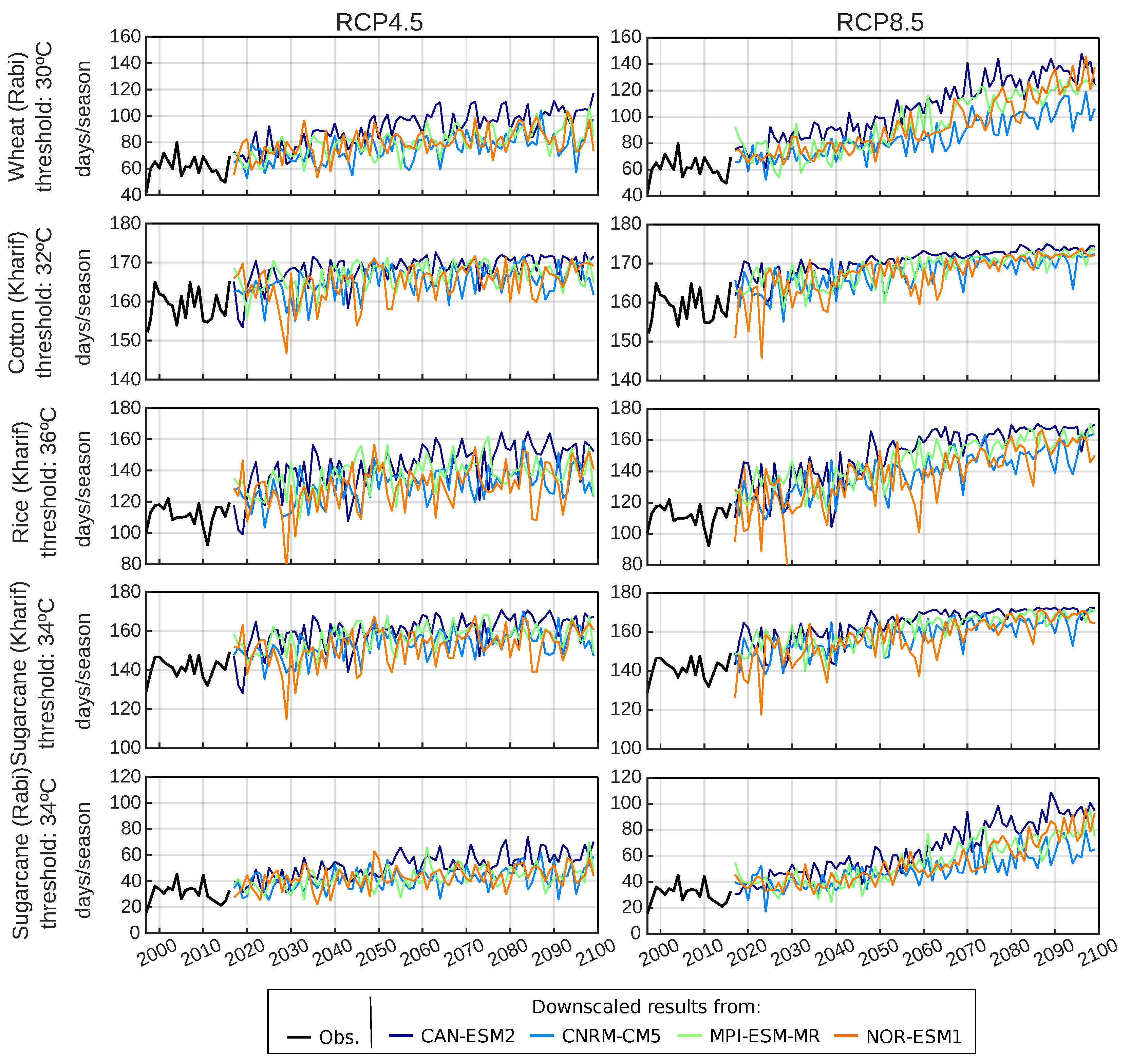
| Station Name | Longitude (°) | Latitude (°) |
|---|---|---|
| BADIN | 68.90 | 24.63 |
| BAHAWAL-NAGAR | 73.25 | 29.95 |
| BAHAWAL-PUR | 71.78 | 29.33 |
| DERA ISMAIL KHAN | 70.92 | 31.82 |
| FAISALABAD | 73.10 | 31.43 |
| HYDERABAD | 68.42 | 25.38 |
| JACOBABAD | 68.47 | 28.30 |
| JHELUM | 73.72 | 32.93 |
| KARACHI (AIRPORT) | 67.13 | 24.90 |
| KHANPUR | 70.68 | 28.65 |
| LAHORE | 74.33 | 31.55 |
| MULTAN | 71.43 | 30.20 |
| MURREE | 73.38 | 33.92 |
| NAWABSHAH | 68.37 | 26.25 |
| SIALKOT | 74.53 | 32.50 |
| Jan | Feb | Mar | Apr | May | Jun | Jul | Aug | Sep | Oct | Nov | Dec | |
|---|---|---|---|---|---|---|---|---|---|---|---|---|
| Wheat (Rabi) | G | G | H | H | P | P | G | |||||
| Rice (Kharif) | P | P | P | G | G | G/H | H | H | ||||
| Cotton (Kharif) | P | P | P | G | G | G | H | H | H | |||
| Sugarcane (Kharif) | G/H | P/H | P | P/G | G | G | G | G | G | G | G | G |
| Sugarcane (Rabi) | G | G | G | G | G | G | G | G | P/H | P/H | P/H | G |
| Related Variable | Indicator | Description | Units |
|---|---|---|---|
| Precipitation | CDD | Largest number of Consecutive Dry Days (precipitation < 1 mm) | days |
| CWD | Largest number of Consecutive Wet Days (precipitation ≥ 1 mm) | days | |
| SDII | Simple Daily Intensity Index | mm/wet day | |
| R20 | Number of very heavy precipitation days (precipitation ≥ 20 mm) | days | |
| Temperatures | TX90p | 90th percentile of maximum temperature | °C |
| SU | Summer days: Number of days with maximum temperature above 35 °C | days | |
| TR | Tropical nights: Number of days with minimum temperature above 20 °C | days | |
| ETR | Extreme diurnal temperature range (difference between the highest maximum temperature and the lowest minimum temperature) | °C |
Publisher’s Note: MDPI stays neutral with regard to jurisdictional claims in published maps and institutional affiliations. |
© 2022 by the authors. Licensee MDPI, Basel, Switzerland. This article is an open access article distributed under the terms and conditions of the Creative Commons Attribution (CC BY) license (https://creativecommons.org/licenses/by/4.0/).
Share and Cite
Heureux, A.M.C.; Alvar-Beltrán, J.; Manzanas, R.; Ali, M.; Wahaj, R.; Dowlatchahi, M.; Afzaal, M.; Kazmi, D.; Ahmed, B.; Salehnia, N.; et al. Climate Trends and Extremes in the Indus River Basin, Pakistan: Implications for Agricultural Production. Atmosphere 2022, 13, 378. https://doi.org/10.3390/atmos13030378
Heureux AMC, Alvar-Beltrán J, Manzanas R, Ali M, Wahaj R, Dowlatchahi M, Afzaal M, Kazmi D, Ahmed B, Salehnia N, et al. Climate Trends and Extremes in the Indus River Basin, Pakistan: Implications for Agricultural Production. Atmosphere. 2022; 13(3):378. https://doi.org/10.3390/atmos13030378
Chicago/Turabian StyleHeureux, Ana Magali Carrera, Jorge Alvar-Beltrán, Rodrigo Manzanas, Mehwish Ali, Robina Wahaj, Mina Dowlatchahi, Muhammad Afzaal, Dildar Kazmi, Burhan Ahmed, Nasrin Salehnia, and et al. 2022. "Climate Trends and Extremes in the Indus River Basin, Pakistan: Implications for Agricultural Production" Atmosphere 13, no. 3: 378. https://doi.org/10.3390/atmos13030378
APA StyleHeureux, A. M. C., Alvar-Beltrán, J., Manzanas, R., Ali, M., Wahaj, R., Dowlatchahi, M., Afzaal, M., Kazmi, D., Ahmed, B., Salehnia, N., Fujisawa, M., Vuolo, M. R., Kanamaru, H., & Gutiérrez, J. M. (2022). Climate Trends and Extremes in the Indus River Basin, Pakistan: Implications for Agricultural Production. Atmosphere, 13(3), 378. https://doi.org/10.3390/atmos13030378








